The AMD Ryzen 9 7950X3D Review: AMD's Fastest Gaming Processor
by Gavin Bonshor on February 27, 2023 9:00 AM ESTConclusion
When AMD unveiled its Ryzen 7 5800X3D with 96 MB of L3 cache, which was made possible with AMD's 3D V-Cache chiplet packaging technology, it changed the game figuratively and literally. In games that can leverage that massive pool of L3 cache to their benefit, the 5800X3D looked like a superstar, but the only thing letting it down was the compute performance on offer. In those situations, it was worse than the existing Ryzen 7 5800X and cost $100 more. It was marketed and targeted at gamers and worked well, but that part was really only the first taste of what was to come – it was only a matter of time before AMD rolled out new X3D SKUs with the better-performing Zen 4 cores.
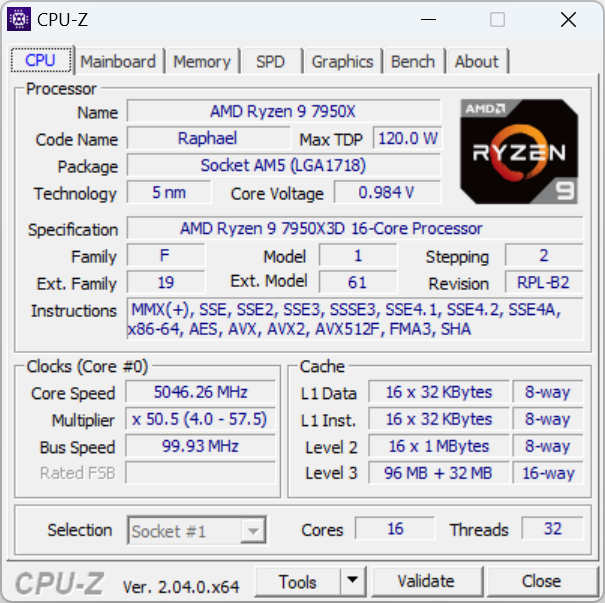
AMD Ryzen 9 7950X3D CPU-Z screenshot
Bringing their V-Cache technology forward to the latest generation of CPUs, AMD has much bigger plans this time around. Rather than only releasing a single part based on a mid-range chip design, AMD has put together a three chip stack that encompasses their flagship CPU configurations for the first time. The combination of AMD's now well-proven Zen 4 CPU architecture and additional L3 cache makes for a potent partnership compared to AMD's previous generational offering, with faster CPU cores and a new scheduling mechanisms to help Windows allocate threads on what is increasingly a non-homogenous CPU architecture.
AMD's decision to build an asymmetrical CPU design makes for some interesting fodder for analysis. Parking CPU cores and altering core priorities on the fly adds a new layer to the onion that is OS thread scheduling, but it's a necessary layer all the same for AMD to make the jack-of-all-trades type of chip that they set out to build. A homogenous chip using two V-Cache equipped CCDs would have been easier to work with, but it would have taken a bigger hit in compute performance, and likely more critically, it would have been even more expensive at time when consumers are already bristling at PC hardware costs.
In any case, with the flexibility of pretty fast cores for compute performance, and an 8-core CCD with 96 MB of L3 V-Cache that soaks up games, the Ryzen 9 7950X3D is a 16-core powerhouse that looks to provide gamers with more performance without asking them to give up too much compute performance in the process.
AMD Ryzen 9 7950X3D Analysis:
We saw different performance levels throughout as we put the Ryzen 9 7950X3D through its paces in our CPU suite. The AMD Ryzen 9 7950X3D will be hitting the streets tomorrow at $699, while the latter is currently available at the time of writing from Amazon for $589. This means the 7950X3D will be carrying a $110 premium over what has been AMD's flagship chip for compute and gaming over the past 5 months.
For this review, we've analyzed the compute and gaming performance separately.
AMD Ryzen 9 7950X3D Gaming Analysis: 3D V-Cache Wins Again in Gaming, But Not in All Titles
When we reviewed the AMD Ryzen 5800X3D, we observed that some titles benefitted from the 3D V-Cache more than others; some of the titles in our suite weren't impacted. And with the Ryzen 7000 family, that hasn't changed – the benefits of the additional 64MB of L3 cache vary from title to title.
A quick summary of gaming performance highlights that games that can benefit from the 3D V-Cache perform very well. Some cases, such as Hitman 3, perform exceptionally better than the competition.
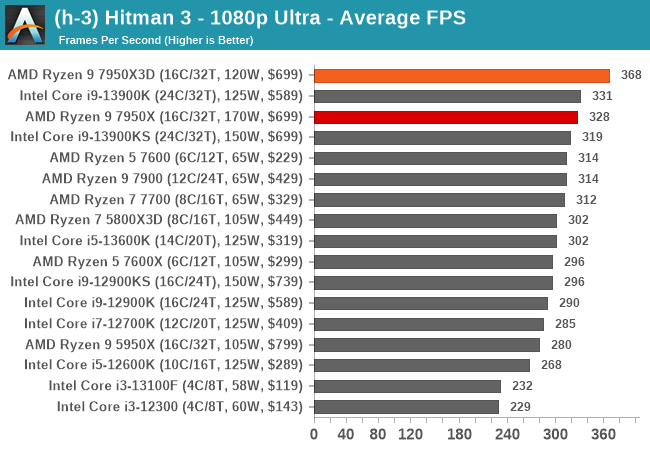
Looking at performance in Hitman 3 at 1080p Ultra settings, we can see that the Ryzen 9 7950X3D outperforms the Ryzen 9 7950X by around 12% in average frame rates. This is quite a jump in performance from just the L3 cache, and it plays into the hands of AMD here. While not all games on the market are optimized for processors with large cores, we can see that the Ryzen 9 7950X3D, when gaming, operates as an 8-core chip with 96 MB of L3 cache, outperforming the Ryzen 9 7950X with 16-cores and faster ones at that.
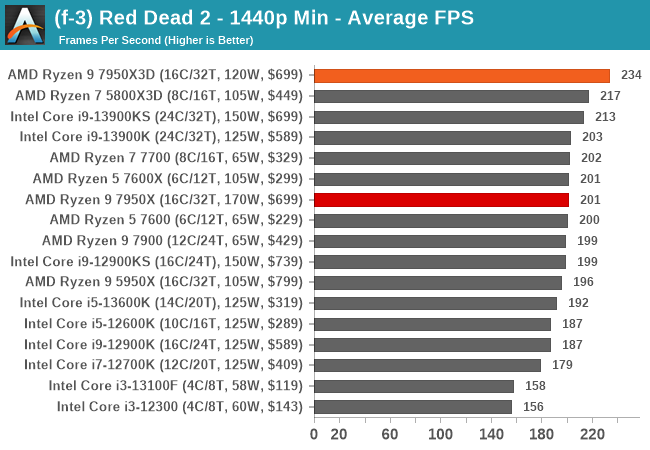
Another title where the 3D V-Cache boosts performance is Red Dead Redemption 2, one of the most popular open-world games. At 1440p minimum settings, we saw an increase of around 16% in average frame rates compared to the 7950X, which is very impressive. Concerning the Ryzen 7 5800X3D, which also showed solid performance levels, the Ryzen 9 7950X3D beat it by nearly 8%.
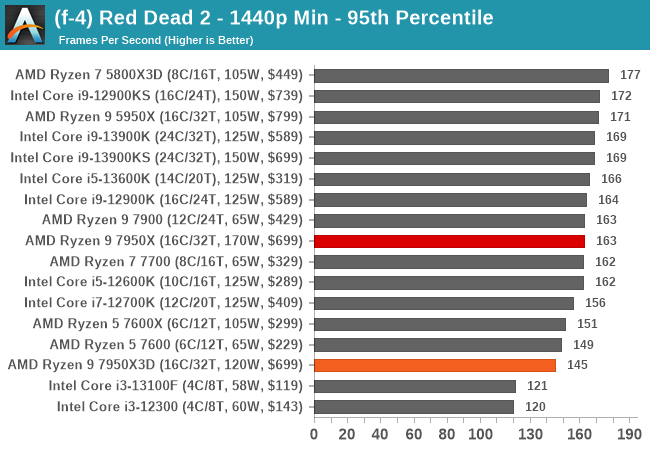
Perhaps the only caveat to the Ryzen 9 7950X3D in gaming came at the 95th percentile, which looks at the slowest 5% of frames. Where minimum frame rates and 5% lows are essential, the Ryzen 9 7950X3D saw 11% lower 95th percentile frame rates when compared to the 7950X. Taking our results in Red Dead Redemption 2 at 1440p as a prime example, we saw average frame rate gains over the 7950X by around 16%, but performance regressed by 12% at the 95th percentile.
Our suspicion here is that we're seeing the lower clockspeeds of the V-Cache CCD rear its head. Bottlenecks shift during the frame generation process (AI, physics, world generation, etc), so where RDR2 benefits from the extra cache in some points, it may now be more compute bottlenecked in others. We did see examples with the Ryzen 7 5800X3D also displaying solid levels of average frame rate performance in some titles, but it was somewhat let down by 95th percentiles in some. The Ryzen 9 7950X3D is more consistent in 5% low performance, and although it wasn't in every instance or every title, we did observe this in Red Dead Redemption 2 and World of Tanks. Like virtually everything else about the additional L3 cache, it's all very situational.
Overall, the gaming performance on display from AMD's Ryzen 9 7950X3D is undoubtedly impressive, and in titles where the 3D V-Cache can be leveraged, the 7950X3D is excellent. As you'd likely expect from hardware changes that improve the CPU, the biggest wins came at 1080p and 1440p resolutions, where the GPU is less likely to the bottleneck. And while 4K performance was still respectable, games are definitely more likely to be hard bound by GPU performance there. Much like the older Ryzen 7 5800X3D, the Ryzen 9 7950X3D is a chip primarily marketed for gamers, and from our testing, it's undoubtedly a smart move from AMD.
As an aside, given just how situational the performance benefits are of AMD's V-Cache, it would be nice to see AMD put together some sort of performance guide, even if it's only on a semi-official basis. Having a list of games that see a performance benefit (and by how much) would be very helpful for buyers trying to decide on whether to splurge on the X3D chip, I believe. This is data AMD should already have in-house, especially as the GPU side of the business is already doing regular automated performance testing for new drivers.
AMD Ryzen 9 7950X3D Compute Analysis: Slightly Slower than the 7950X
Although the AMD Ryzen 9 7950X3D makes for a potent improvement in gaming workloads, there are far fewer examples of general computing workloads where the large amounts of L3 cache outweigh higher CPU frequencies. While AMD has narrowed the gap versus what we saw with last year's single-CCD 5800X3D, the crux of the matter is the Ryzen 9 7950X3D still ends up being slower than the Ryzen 9 7950X in most computing tasks. While AMD's drivers, optimizations, and CCX switching in games work well, for anything that can fire up more than 16 threads – enough work to spill over in to both CCDs – the clockspeed penalties from the V-Cache CCD and overall lower TDP inflict a price.
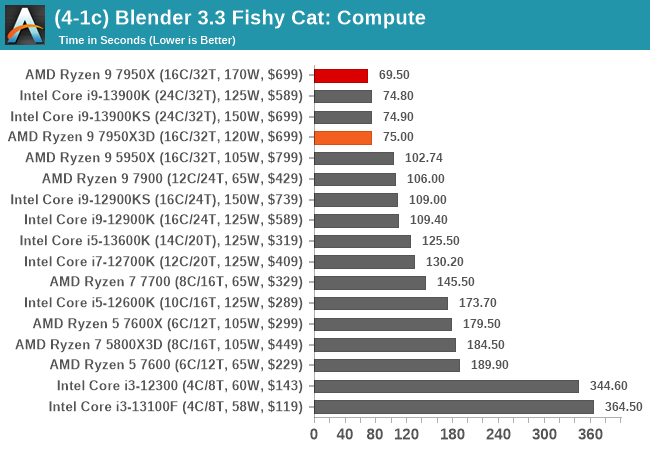
Taking examples from our CPU suite as a prime example that the Ryzen 9 7950X3D is slightly slower than the Ryzen 9 7950X in compute, we can see in the Blender 3.3 Fishy Cat (rendering) test that the Ryzen 9 7950X3D is around 7% slower than the Ryzen 9 7950X. This test put the Ryzen 9 7950X3D below the Intel Core i9-13900KS and 13900K, whereas the Zen 4 16 core goliath, the 7950X, does best. The Ryzen 9 7950X is a rendering beast, and although the Ryzen 9 7950X3D still performs well, the proof is in the pudding that users not too fussed about gaming are likely better off sticking with the architecturally homogenous (and very highly clocked) 7950X.
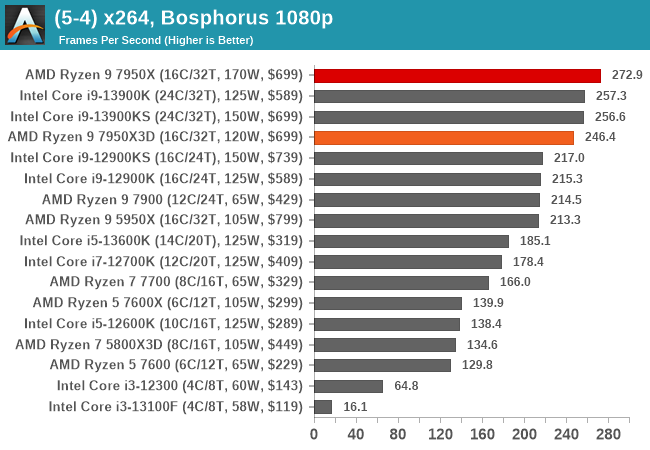
In encoding performance, and using our results in the x264 Bosphorus 1080p benchmark, we see much of the same again between the Ryzen 9 7950X3D and 7950X directly, as well as the positioning of the performance including the flagship 13th Gen Core i9-13900KS and 13900K processors. The Ryzen 9 7950X3D was a bit less than 10% slower than the Ryzen 9 7950X in this particular test, while it was only 4% slower than the Core i9-13900KS. I would still consider this a win for AMD, to an extent, as both chips will retail for similar prices, while the Ryzen 9 7950X3D offers more scope in gaming performance due to the inclusion of the 3D V-Cache.
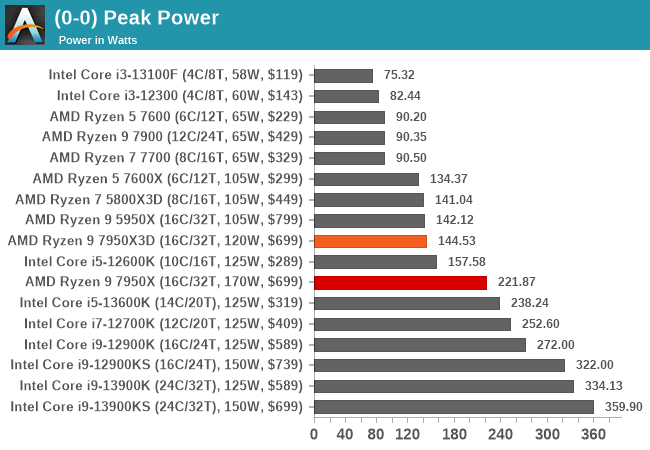
Ultimately, the Ryzen 9 7950X3D still performs respectably in rendering, encoding, and other intensive workloads, but it's clear that the Ryzen 9 7950X still holds the performance crown here for AMD. Given that the Ryzen 9 7950X3D at full load uses around 35% less power than the 7950X, this would always impact performance. Despite this, the Ryzen 9 7950X3D still performed well in our compute section, showing that Zen 4's performance per watt efficiency is excellent. If anything, the 7950X is the outlier in this respect, as these results again underscore how AMD had to sacrifice a lot of that efficiency in the name of attaining all-out performance for their fastest parts.
AMD PPM Provisioning & 3D V-Cache Performance Optimizer Aren't Always Right
Focusing on AMD's new PPM Provisioning and 3D V-Cache Performance Optimizer drivers, we did come across an example where putting all the workload on both CCDs yielded the wrong outcome for performance. Technically an edge-case scenario, we found that AMD's drivers and Microsoft's Xbox Game Bar failed to properly detect that the headless benchmark version of Factorio was running.
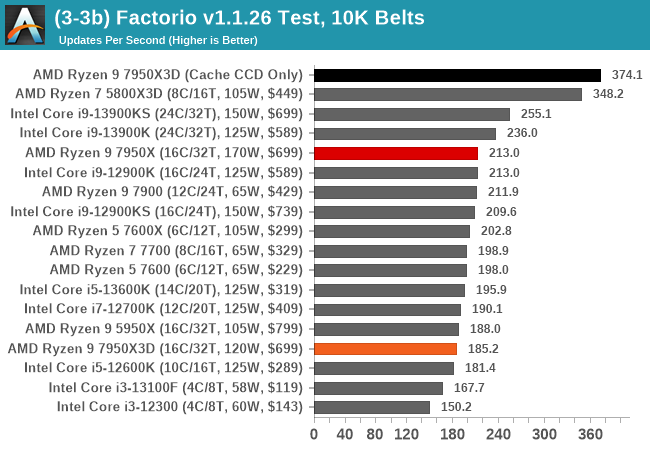
As we can see in our Factorio benchmark, we saw massive gains of over 100% when forcing the Ryzen 9 7950X3D to use the CCD with the 3D V-Cache, as opposed to letting AMD's PPM Provisioning and 3D V-Cache Optimizer drivers do their things automatically. Otherwise, when left to their own devices, X3D software stack – and specifically, the Xbox Game Bar – weren't able to recognize our Factorio benchmark run as a game that warranted intervention.
Factorio aside, we saw the AMD PPM and 3D V-Cache Performance Optimizer drivers working very well throughout our testing. So, while there's clear room for improvement, AMD's first foray into heterogeneous CPU cores is on the right track.
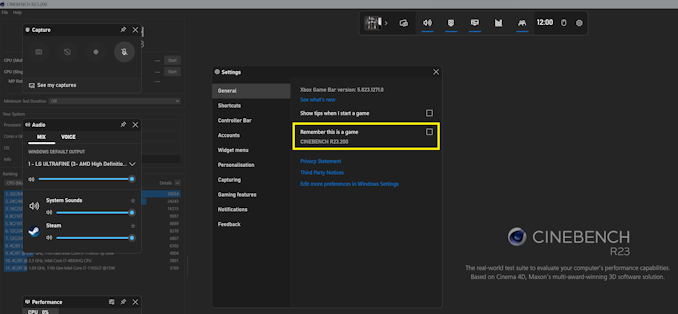
Users can force the Ryzen 9 7950X3D to use the 3D V-Cache in Xbox Game Bar.
For users who want to force the system to use the CCD with the 3D V-Cache, it can be enabled in the AMD Ryzen Master software, as well as within the firmware. Users can also circumvent the software by opening software or a game unfamiliar to the Xbox Game Bar and ticking the check box to tell the Game Bar that the active application is in fact a game. At the end of the day, AMD has firmly attached their buggy to Windows' Game Mode here, so how well Windows identifies games is going to dictate whether a program gets sent to the right CCD.
Final Thoughts: The Ryzen 9 7950X3D is For Gamers, But It's Still Respectable in Compute
AMD's Ryzen 9 7950X3D is targeted more at gamers than content creators. What's interesting about the new Ryzen 9 7950X3D when directly compared to the Ryzen 7 5800X3D is that the 7950X3D further enhances AMD's 3D V-Cache chiplet packaging. The Ryzen 9 7950X3D benefits from 128 MB of 3D V-Cache (96 MB on one CCD) and has the latest Zen 4 cores based on TSMC's 5 nm node, which has an IPC and frequency advantage over Zen 3.
Where the similarities end between the Ryzen 9 7950X3D and the Ryzen 7 5800X3D, the Ryzen 9 7950X3D does gaming excellently in titles that can leverage the 3D V-Cache, but it also has plenty of grunt from the 16-cores in compute tasks. Although we saw just one X3D SKU from AMD's Ryzen 5000 generation, AMD is releasing three for Ryzen 7000.
The most expensive and perhaps best of these Ryzen 7000X3D SKUs is the Ryzen 9 7950X3D, which has an MSRP of $699, and although we haven't reviewed the Ryzen 9 7900X3D, and the Ryzen 7 7800X3D doesn't launch until April, the Ryzen 9 7950X3D should fare better than the others in compute performance. Regarding gaming performance, it's hard to judge if the Ryzen 9 7950X3D will outperform the Ryzen 7 7800X3D when it launches.
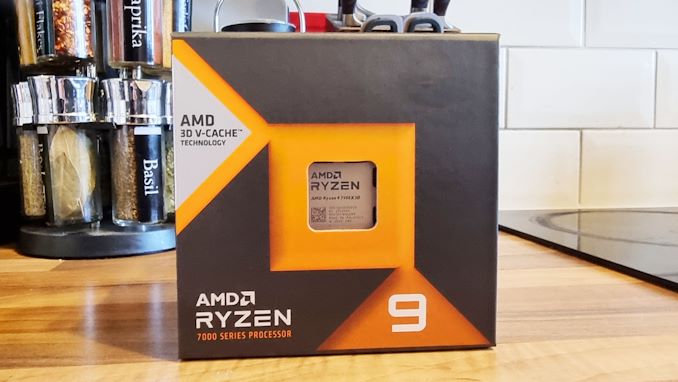
AMD has cooked up an absolute gaming powerhouse with the Ryzen 9 7950X3D
This is because the Ryzen 7800X3D is an 8-core/16-thread part with 96 MB of 3D V-Cache on one CCD, while the Ryzen 9 7950X3D operates as an 8-core/16-thread part with 96 MB of 3D V-Cache when in 'gaming mode. So, taking the above into account when factoring in gaming performance for the price, the Ryzen 9 7950X3D has an MSRP of $699, while AMD intends to launch the Ryzen 7 7800X3D for $449 on the 6th of April. Both of these chips should have similar levels of performance in many games, providing a quandary for users and gamers alike to decide.
For users looking for a solid all-around chip that can deliver leading gaming performance but still hang with the top dogs from Intel and AMD in compute performance, the Ryzen 9 7950X3D is an excellent offering. Even at $699, it represents a leading-edge offering with the latest Zen 4 cores packaged with AMD's 3D V-Cache. It benefits gaming performance in specific use cases where the game can leverage a large level of L3 cache.
If you're looking for the highest levels of compute performance for tasks such as video rendering and content creation, and it has to be Ryzen 7000, then the Ryzen 9 7950X still holds the overall performance crown. AMD has done a superb job with the Ryzen 9 7950X3D making it the fastest gaming processor in titles that can use the 3D V-Cache, while still offering decent performance in compute; that's a win for AMD. AMD's PPM Provisioning and 3D V-Cache Performance Optimizer drivers both work well and bolster the overall efficacy of the processor to deliver the right workload to the suitable CCD.
The Ryzen 9 7950X3D is still respectable, but if gaming isn't your thing, then the Ryzen 9 7950X is currently cheaper than the 7950X3D at $589 from Amazon and still offers a good balance between gaming and compute performance. Otherwise, if gaming is your thing and you're well informed that the titles you play the most can benefit from the 3D V-Cache, then the Ryzen 9 7950X3D is the way to go.
It could be worth waiting for the Ryzen 7 7800X3D if gaming is the only thing you do, as it's around 55% cheaper (at MSRP) than the Ryzen 9 7950X3D and should, in theory, offer the same levels of gaming performance. It should also be noted that the Ryzen 7 5800X3D is currently on offer from Amazon for $323, representing excellent value for gamers.










122 Comments
View All Comments
demian_thorne - Wednesday, March 1, 2023 - link
It is typical under articles and threads like this to hear and see all kinds of extreme opinions based on everyones personal pet peeves...I think your comment was the most sensible of them all ! Very well done !
milleron - Monday, February 27, 2023 - link
Thanks. For me, your testing suggests pretty strongly that I am best served by simply keeping my current 7800X3D rig — i.e., keep the current motherboard, 7800X3D, RAM, and SSDs but spend the money upgrading from an RTX 3080 to a 4080 or 4090. I WOULD like to see a test of MS Flight Simulator at 1440 and 4K before a final decision, but those should be forthcoming from the MFS forums soon enough.AvidGamer - Monday, February 27, 2023 - link
Do you happen to work for AMD or one of its system partners? If not you most likely intended to write 5800X3D right? After all the 7800X3D hasn't been released yet, at least not to my knowledge at the time of writing.milleron - Monday, February 27, 2023 - link
Sorry, regarding the above post, I currently have a 5800X3D rig, NOT a 7800X3D, which, obviously, does not currently exist. Too bad this website doesn't allow editing of comments.Gavin Bonshor - Monday, February 27, 2023 - link
The 5800X3D is still a VERY GOOD processor for gaming. And given it's around $330 right now and can be paired with DDR4 memory/AM4 motherboards, for the price, it'll be hard to beat for gamers on a budget.Of course, a discrete graphics card is required, but the more spent on a GPU, the better the gaming performance will be.
rb86 - Monday, February 27, 2023 - link
You said in the comments you're still doing testing. Will a new article be posted with your updated results or will this article be modified? These Factorio results are shockingly disappointing. Is there no way to force an application to start on the core with the 3D cache on it?Gavin Bonshor - Monday, February 27, 2023 - link
I certainly am, and they are running while I do my evening things. As the tidbit on the last page highlighted, Factorio performance SHOULD be higher, but AMD's PPM/3D V-Cache Performance Optimizer drivers didn't pick up the fact Factorio was running. This is primarily due to our benchmark that is running without a UI, and it's possibly why XBOX Game Bar didn't pick it up.On that note, I'll be doing more testing with the 7950X3D set to Cache and Frequency to see if AMD's drivers got it wrong on more in our test suite than just Factorio and possibly Dwarf Fortress.
As for if it will be an article update or a fresh page, I would say the update is more likely, but this will be explored when I have the data and if it makes THAT much of an impact on performance.
We shall see, but first, I need to collect more data.
flydian - Monday, February 27, 2023 - link
So far, all this has done is to sell me on the Ryzen 5 7600X. Maybe I'll wait for that 7800X3D before buying parts to upgrade from my 10th gen Intel CPU.meacupla - Monday, February 27, 2023 - link
the driver to park CPU cores to get windows to use the correct cores when gaming seems like such a hack workaround. I think AMD should have stuck to homogeneous cores, or gone the intel route and have a big-small configuration that the OS has an easier time of handling.Otritus - Monday, February 27, 2023 - link
The problem with big small is what is a big-core? Some workloads need higher frequency, others higher cache, and some a bit of both. I don’t understand why DirectX and Vulcan API calls couldn’t have been automatically routed to the V-cache CCD, and everything else to the frequency CCD. AMD clearly needed to spend more time optimizing the scheduler for their processors. Intel spent years building a new hardware scheduler and directly working with Microsoft to maximize performance.